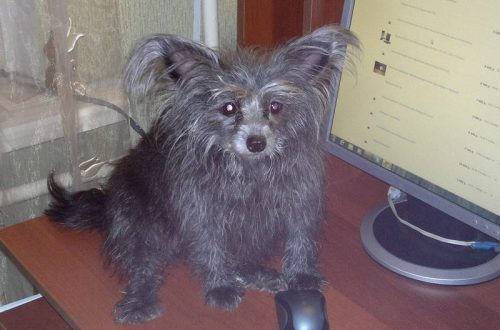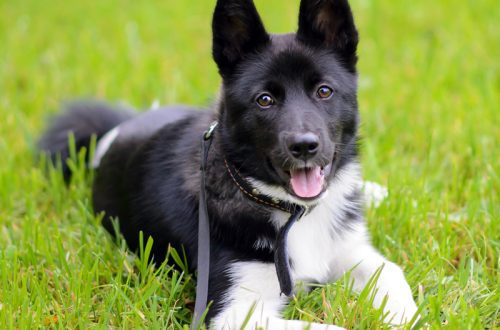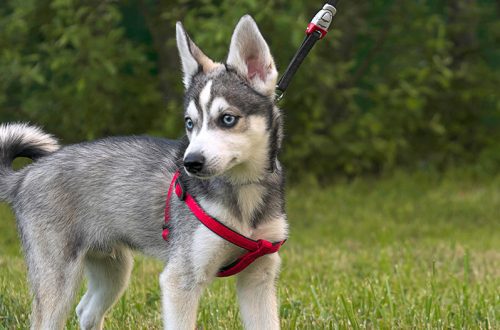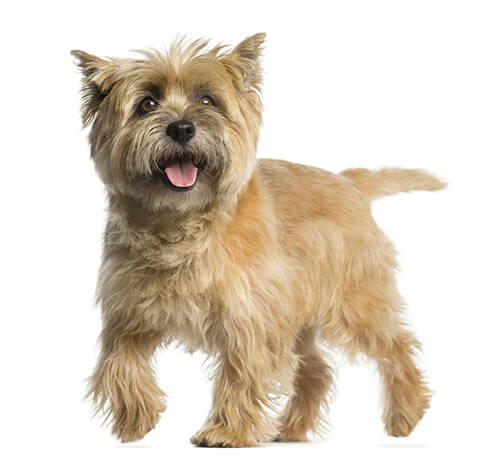
Cairn Terrier
Other names: cairn terrier , cairn
The Cairn Terrier is one of the oldest breeds of Scottish Terriers, having specialized in catching foxes and rodents since ancient times. It is an energetic, positive companion dog with a wiry, bristling coat and pointed, erect ears.
Contents
Characteristics of Cairn Terrier
| Country of origin | Scotland |
| The size | average |
| Growth | 23–30 cm |
| Weight | 6–7.5 kg |
| Age | 12–15 years old |
| FCI breed group | terriers |
Basic moments
- Like all terriers, Cairns are quick-tempered and stubborn, but causeless aggression is not inherent in the breed.
- With all his love for nature and freedom of movement, the Cairn Terrier is able to become a city dweller. The main thing is not to limit the dog in walking and to choose the right set of sports exercises for it.
- In everyday life, Cairn Terriers communicate with a moderate voice. If the dog is too talkative and responds with barking for any reason, most likely, it was often left alone for a long time.
- The breed is friendly towards children. Caring and helpful nannies from Cairn Terriers, as a rule, do not work, but the animators are not bad.
- The characteristic shaggy coat of cores is not only a natural gift, but also the result of the owner’s painstaking work, so learn the basics of grooming and proper trimming in advance.
- In the cinema, the breed has its own “niche” since 1939. Movies and series in which you can meet Cairn Terriers: The Wizard of Oz (1939), The Understudy (2013), Kingsman (2015), Mr. Robot (2015) ).
- The second friend of the Cairn Terrier after the owner is food. Even an absolutely well-fed pet will never refuse a supplement, and on a walk it will actively dig up the ground in search of “delicious” insects.
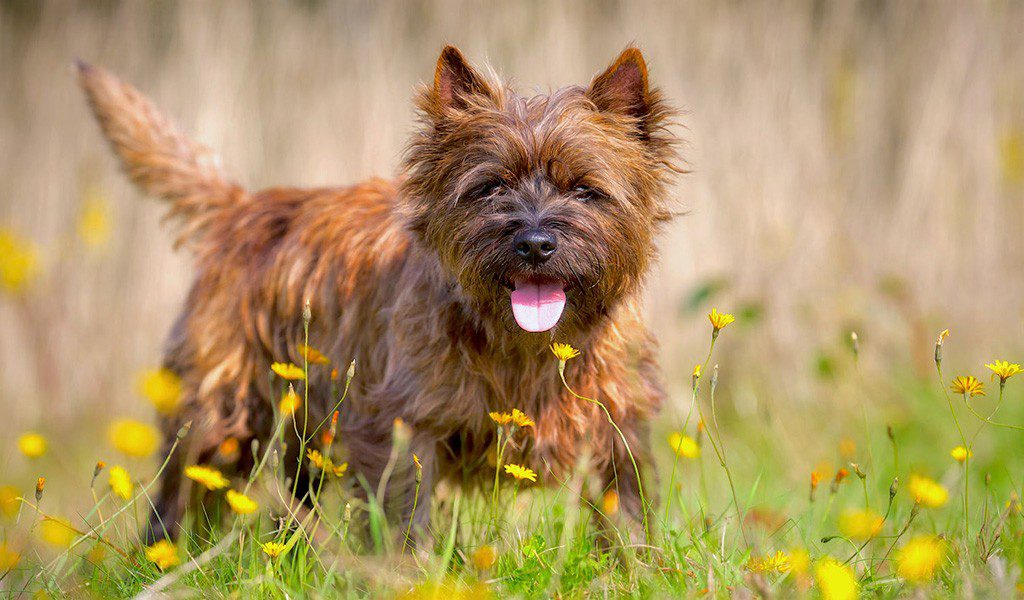
The Cairn Terrier is a professional hunter in the past, but in the present, a compact, shaggy merry fellow and a tireless sportsman who loves outdoor games. Like all representatives of the terrier group, the kern is overly curious and fantastically passionate when it comes to searching for something, but at the same time it is incredibly friendly and sociable. If you want to truly become friends with a breed, make its representative your constant companion. It is difficult to find a happier and contented creature than the Cairn Terrier, who accompanies the owner on equal terms on bike rides, mushroom picking or during a leisurely promenade through the city streets.
History of the Cairn Terrier
Kerns are often referred to as the great-grandfathers of all Scottish terriers, since references to hunting foxes and badgers with these clockwork cosmats date back to the 16th century. At first, all representatives of the breed were called pointy-eared Skye Terriers – after the name of the Isle of Skye, whose inhabitants preferred small dogs that skillfully caught rodents and small animals. It was decided to replace the root “sky” with “core” only at the beginning of the 20th century, when the question arose of standardizing animals – the name “core terrier” indicated that the breed copes well with the capture of predators in mountainous and rocky areas.
Despite the fact that the Scottish captain McLeod, who presented the most viable and working line of the breed, is considered the first professional breeder of cores, the breeding of dogs went on spontaneously for a long time. In particular, every British farmer considered it his duty to carry out a series of selection experiments, which, in his opinion, could make more grasping and prolific helpers out of Skye Terriers.
Official recognition for the breed, as well as a new name, came in 1910, after the English Kennel Club registered individuals belonging to the breeder Alistair Campbell. Since then, Cairn Terriers have become full-fledged participants in dog shows, although until 1923 they were still crossed with West Highland White Terriers to get animals with a glamorous snow-white color.
Video: Cairn Terrier
Cairn Terrier breed standard
The Cairn Terrier is a combination of funny appearance and lively temperament. Perky, shaggy mustaches dressed in fur coats look like they just jumped off the shelf of a toy store. Add to this a modest weight (only 6-9 kg), a low landing typical of terriers and an overall compact physique – and you have an exemplary representative of the breed, assertive, restless and terribly curious.
Head
Small, proportional to the body of the animal, with a pronounced hollow between the eyes and a powerful muzzle. The stop is embossed, clearly visible.
Teeth and jaws
Cairn Terriers have large teeth and strong but not heavy jaws with a standard scissor bite.
Nose
Black, with a moderately developed lobe.
Eyes
The eyes of the purebred Cairn Terrier are set wide apart and hidden under shaggy eyebrows, which gives the dog a comical and slightly angry look.
Ears
The pointed, triangular-shaped ears are always in an alert position (standing upright).
Neck
The neck of the Cairn Terrier is moderately long, with a classic set.
Frame
A purebred representative of the breed should have a flat, medium length back and a flexible loin. The chest of the Cairn Terrier is massive, with well-rounded ribs.
limbs
The Cairn Terrier has very strong and strong legs with sloping shoulders, impressive hips and low hocks. The front paws are much larger than the hind ones, the paw pads are elastic and convex. The dog moves smoothly, with a strong push from the hindquarters and a uniform reach of the forelimbs.
Tail
In a familiar environment, the Cairn Terrier carries its short tail provocatively and energetically, without lowering it downwards and not throwing it on its back.
Cairn Terrier Wool
The coat of a dog is almost a defining breed characteristic. Double, with ultra-coarse outer coat and short, tight undercoat, it performs a protective function – it does not allow the animal to get wet in bad weather and reduces the risk of mechanical injury.
Color
Purebreds should have cream, red, wheaten, ash black or gray coats. Cairn terriers with pronounced brindle are also not plembars and are allowed to participate in exhibitions.
Disqualifying vices
Aggression or unreasonable fearfulness of a dog is an unconditional disqualification. Animals that have atypical colors such as solid black, white, and black and tan are also not allowed to participate in the competition.
Character of the Cairn Terrier
Kerns are the most typical representatives of the terrier clan, so when you bring them into the house, get ready for boundless curiosity, light courage, instant reaction and pranks. In addition, this is an extremely contact breed that loves to demonstrate its intellectual and athletic achievements to humans. Whatever tricks and tricks the kernel sets, he has one ultimate goal – to arouse the owner’s interest in the results of his “labor”. Yes, often the shaggy “superdog” goes too far in an effort to impress the owner with his own ingenuity and restlessness, but it makes no sense to blame him for this.
The Cairn Terrier is an owner and a terrible miser who does not recognize the concept of “common property”. He will happily play catch-up with the children, willingly chase the ball and bring it, but any encroachment on personal belongings (a toy, a bone) will answer with a convincing “Woof!” or a warning grunt. At the same time, in other everyday situations, the breed demonstrates quite peaceful behavior. An exception is a threat to the life of the owner coming from another dog. In such a case, it is incredibly difficult to keep the core, but it is vital to do this – in the heat of excitement, the shaggy “Scot” crosses all boundaries and ceases to soberly assess his own strengths.
Almost all modern Cairn Terriers have “tied up” with hunting qualifications and live happily in city apartments, but do not expect that they have forever said goodbye to stalking instincts. Plowing a newly planted flower bed in search of a mole who once visited it and bringing a stray cat to a heart attack for a Cairn Terrier is a sacred thing. It is not very easy to reconcile a dog with other pets. This comrade sees a direct competitor in any four-legged creature, which must be neutralized as soon as possible. No, the kern is absolutely not bloodthirsty, so “surviving” the opponent from his territory will be by other methods – ringing barking, light biting and chasing.
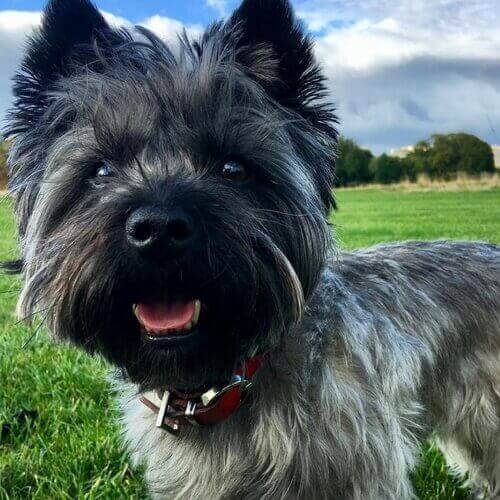

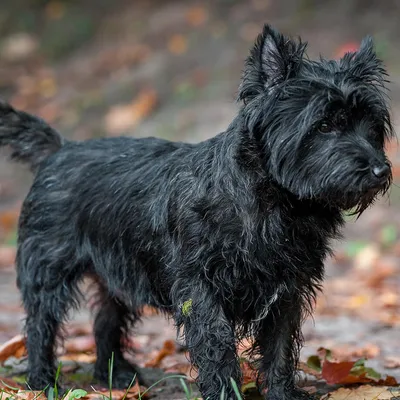

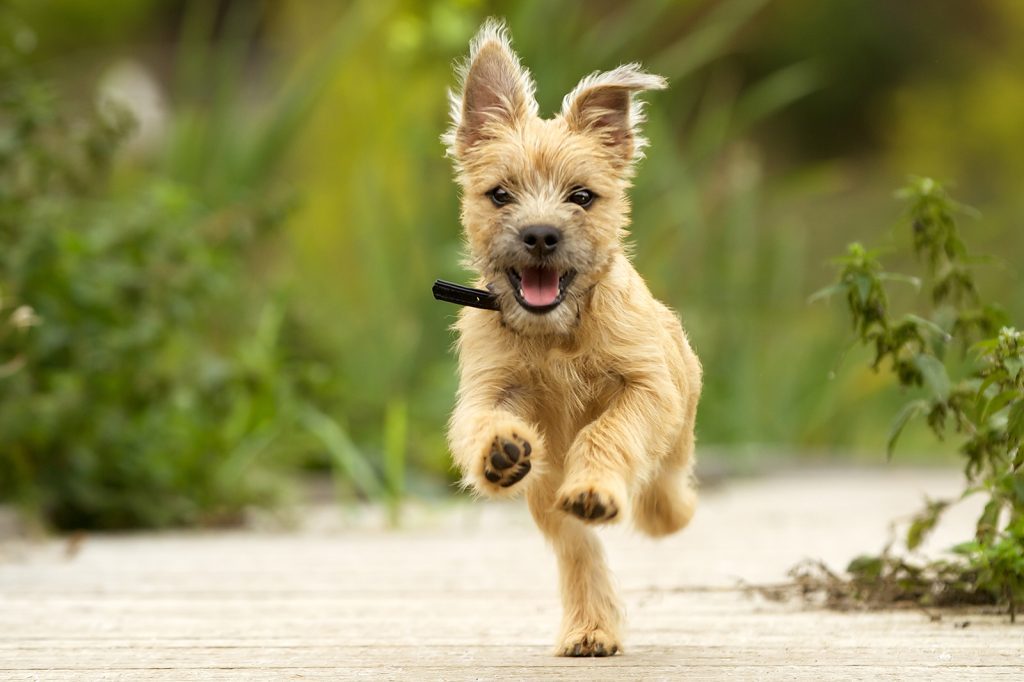

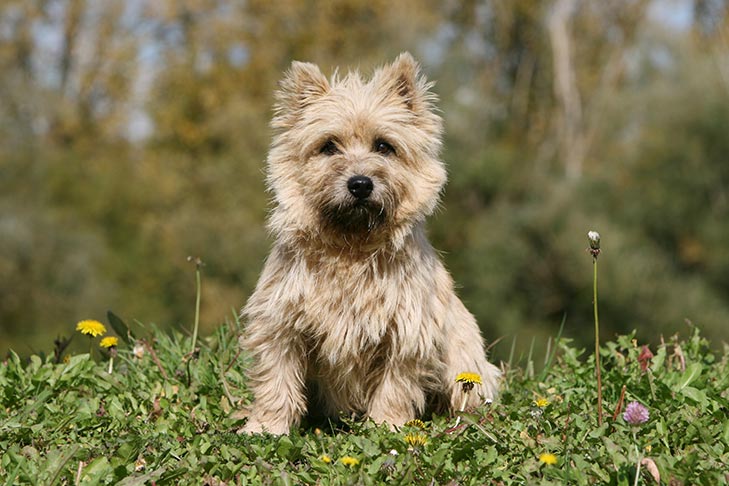

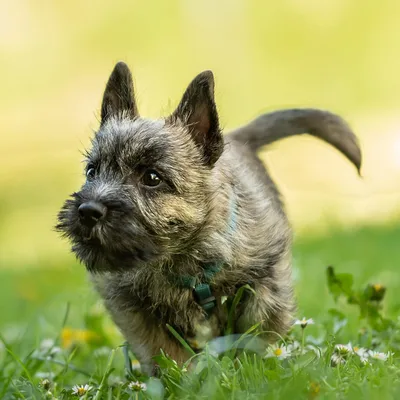

Education and training
The Cairn Terrier is an intelligent and curious breed, as long as you don’t yell at the pet. Impulsive “Scots” perceive any pressure as an infringement of personal rights, to which they react violently. Moreover, an offended core shows real miracles of stubbornness and disobedience, and it becomes impossible to explain elementary truths to him.
Another characteristic feature of the breed is the duality of behavior. Each individual expresses this quality differently. Someone, in the absence of their owners, is lying on sofas and ottomans, but upon hearing the sound of a key turning in the door, they immediately transform into an exemplary pet, peacefully dozing at the threshold. Someone slowly harasses the cat, and then, when the owner appears, he pretends to see a meowing creature for the first time.
Cynologists assure that turning a Cairn Terrier into a well-mannered “city dweller” is not very easy, but real. The main thing is to look for individual approaches and not get hung up on one technique. Assert your own leadership persistently, but without rudeness, restrain emotions and do not yell at the ward – this will make it easier for the dog to adapt to your requirements. By the way, during the initial training of the breed, experts recommend not using the “No!” command, replacing it with the word “You can!”. It is easier for a young Cairn Terrier to perceive the approval of his own actions than rude prohibitions. In addition, this teaches the animal to look at the owner more often in order to obtain permission for a specific act.
You can regulate the dog’s behavior not only with voice commands, but also with gestures. Cairn Terriers understand them perfectly and instantly react. Moreover, they themselves skillfully express intentions with postures and movements of the tail. Guessing that the core is ready to play and is about to take off is easy – the animal takes a “low start”, tries to establish eye contact with the owner and vigorously wags its tail.
Maintenance and care of Cairn Terrier
The Cairn Terrier should have an isolated corner in the apartment (couch, house), where he could rest and store his own “treasures”. Be sure to buy some toys for the animal: cores grow up quickly, they need educational fun with objects. And during the absence of the owners, the pet will have something to do. However, you should not overwhelm the dog with gifts either. Representatives of this breed are very selective and often remain faithful to one ball, gently ignoring other things. By the way, about the balls: they should be soft and relatively large so that the Cairn Terrier cannot swallow them.
Owners living in a private house with a garden or a personal plot will have to be extremely prudent when releasing the dog to “breathe”. It is not a problem for the Cairn Terrier to dig under the fence and run off in an unknown direction. As for the toilet, tiny cores quickly get used to using newspaper for “wet business”, and then relatively easily relearn how to do the same on the street.
Hygiene
Cairn Terriers only look like unpretentious cosmetics. In reality, pet hair requires systematic care. Firstly, because cores do not shed, which means that the dog must be trimmed, removing dead hair and stimulating new growth. Usually individuals that do not participate in exhibitions are trimmed 3-4 times a year. Show cores are “pinched” by the owners every two weeks, once a month they are taken to a professional salon, where the business started by the owner is “polished” to perfection.
Secondly, the undercoat of the breed is prone to the formation of tangles, so if you do not plan to grow a “boot” out of a four-legged friend, you need to brush it once or twice a week, paying special attention to the armpit area. An important point is the haircut. In fact, it is contraindicated for Cairn Terriers, since it changes the structure of the coat, softens and thins it. However, sometimes scissors have to be used to make the dog’s silhouette more prominent. Kerns usually trim the hairs in the lower abdomen and form the contour of the paws, along the way removing the hair between the fingers and under the tail. Tidying up the rest of the body, including the ears, which are usually abundantly overgrown, will have to be done by pinching.
Do not abuse water procedures. Western breeders are of the opinion that frequent bathing is harmful to the breed, and recommend washing Cairn Terriers only in the most emergency situations. For example, when the animal fell out in the mud or fell. In other cases, “bath days” are unnecessary, since the coat of cores does not give a specific smell, provided that the dog is systematically trimmed. Show pets will have to be washed more often – once every 2-3 months and exclusively with professional shampoo for wire-haired breeds.
Be sure to observe the hygiene of the genital organs. This is especially true for bitches, who during estrus are advised by breeders to rinse the loop and the area around it with warm water, as well as treat with neutralizing sprays to help remove the characteristic smell of discharge. In addition, the soft hair around the genitals rolls more often than on the rest of the body, so learn to carefully cut the tangles with scissors.
Brushing your teeth is a necessary procedure in the life of a Cairn Terrier. Ideally, the pet’s mouth should be treated three times a week, but with an acute shortage of time, the number of cleanings can be reduced to two. Choose the right size finger brush and paste that the core will like. An excellent prevention of the appearance of tartar in dogs is the use of natural juices, such as lemon or tomato. They can soak a napkin and clean the animal’s oral cavity, carefully rubbing the juice into the tooth enamel. And do not forget, from 4 to 6 months, the Cairn Terriers change their milk teeth, so for this period it is better for four-legged naughty to get a chewing toy that will help to distract and massage the gums.
Check your Cairn Terrier’s eyes daily for any moisture or debris. To do this, use a clean cloth moistened with boiled water or phytolotions from a zoo pharmacy. Kernam ears are cleaned once a week with a damp cloth or rag. It is strongly not recommended to use hydrogen peroxide for hygienic treatment of the auricle, which causes skin irritation. It is more correct to replace it with chlorhexidine.
Cairn Terrier – Walking and exercise
An adult Cairn Terrier is a good runner, but usually a two-time walk is enough for him to emotionally and physically discharge. At the same time, he loves outdoor games and sports. So, when taking your pet outside, give him the opportunity to stretch to the maximum – make him run after the ball, involve him in games of chasing and searching for objects, teach him to comprehend the basics of agility.
It is allowed to lower the core on a walk from the leash if the shaggy rogue has perfectly mastered the commands from the UGS course and correctly responds to the call. Otherwise, get ready to run after your pet to re-fasten the strap. Well, a little about the favorite pastime of all terriers – digging. In no case do not let the dog ruin other people’s beds and garden beds, but do not pull up if she is “digging” in a wasteland in order to get edible roots and insects – giving vent to instincts for an animal is vital.
Feeding
The average Cairn Terrier gives the impression of an eternally hungry creature in a permanent search for food. So if you succumb to the constant begging looks of your pet, you risk growing a fat lump, which you will then have to treat with a nutritionist. At four months old, a Cairn Terrier puppy is completely ready to switch to three meals a day, and at six months, the number of feedings can be reduced to two. Don’t worry, the dog won’t die of hunger. In any case, if the baby has worked up a brutal appetite, he can be encouraged with a small snack.
If the opposite is true and the Cairn Terrier doesn’t finish his serving or touch his dinner because it doesn’t meet his expectations, it’s good for him to “unload” and skip one feeding. As for harmful products, for cores it is pork, fatty lamb, sweets, any smoked meats, bones and veins. Sometimes a doggie can be treated with an ordinary sandwich with butter or cheese, or cottage cheese – such “human” food will not bring harm. In addition, from an early age, the Cairn Terrier needs to be taught to eat fruits, berries and vegetables – they are more useful than vitamin supplements from a veterinary pharmacy.
Approximate diet of an adult: 40% – meat and its waste, 30% – cereals, 20% – sour-milk products, 10% – fruit and vegetable purees and salads. If the owner is limited in time and does not have time to prepare individual meals for the pet, industrial feeds and canned food can be considered as an alternative, provided that the owner is ready to spend on brands not lower than super premium, but preferably holistic class.
Health and disease of Cairn Terriers
The ancestors of the Cairn Terriers, despite their more than modest build, could boast of iron health and amazing endurance. Their descendants are also not frail creatures, but the breed is more susceptible to hereditary ailments. In particular, like all representatives of the terrier clan, Perthes disease is often diagnosed in cores, the course of which is accompanied by lameness and is due to genetics.
Poor blood clotting (Willebrand’s disease) is also a genetic disease that is inherited from producers to offspring. In addition, like any small breed dog, Cairn Terriers suffer from a luxating patella. An unpleasant phenomenon is directly related to the size of the animal and does not depend on the quality of pet care. Of the specific diseases inherent in cores, veterinarians most often note allergies, obesity and cataracts.
How to choose a puppy off Cairn Terrier
- Buy a Cairn Terrier puppy in a monobreed nursery – this way there are more chances that you will come across a knowledgeable breeder for whom animal breeding is not a commercial goal, but a matter of life.
- Visit the kennel several times to see how the puppies behave in everyday life: whether they are playful, how they react to the presence of a stranger, whether they eat with appetite.
- The hanging ears of a puppy are not at all an indicator that they want to deceive you. In purebred Cairn Terriers, the ear lining rises at the 5th week of life, but more often this process stretches for months.
- The coat color of newborn Cairn Terriers is different from what the animal will acquire when it matures. So if you are afraid to make a mistake, wait until the babies are 12 weeks old – by this time their true “color” will appear. By the way, with age, the shade of the “fur coat” of a dog may lighten (typical for wheat cores) or darken – this is normal.
- Getting a promising puppy with whom you can conquer exhibitions and dog shows is problematic, since interested breeders keep the best Cairn Terriers from the litter. If the seller decides to give away the future “show star”, scrupulously study the exhibition diplomas and pedigrees of her parents to make sure that you are being sold an animal with genetic potential.
- Ask the breeder if the puppies have been tested for hereditary pathologies – patella, heart disease, cataracts. If so, please ask for the test results.
Cairn Terrier price
In Russia, Cairn Terriers are not exotic, but not the most popular breed, so there are very few serious kennels breeding them. The cost of puppies is far from the budget, unless it is offspring from an unscheduled mating or mestizo. As an example: the average price tag for a pet class Cairn Terrier with a pedigree and from eminent parents is 800$. The kids of the top show category are another plus of 350$ – 500$ to the average cost, and the exhibition “girls” cost much more than the “boys”.





